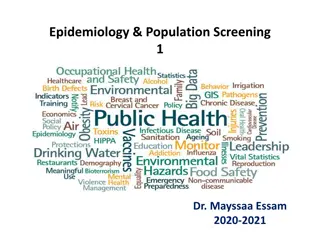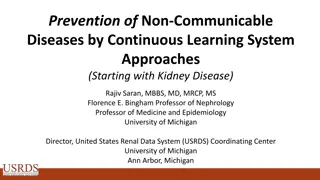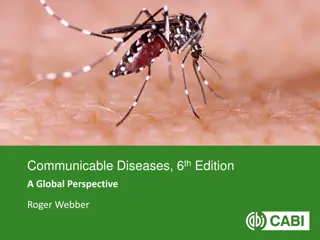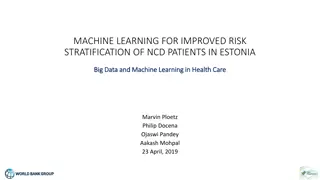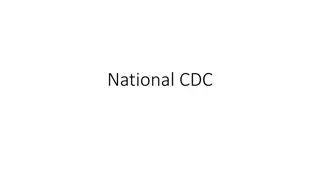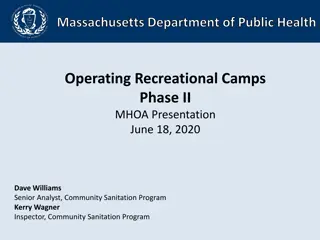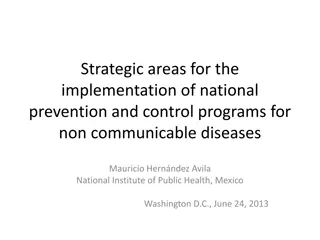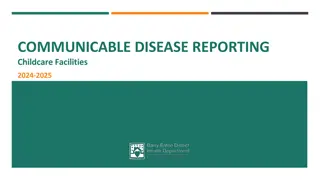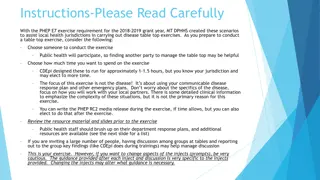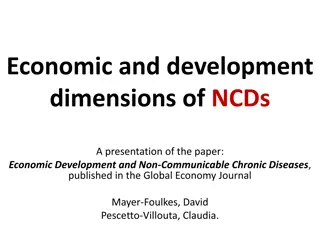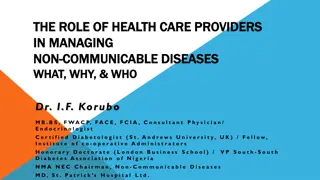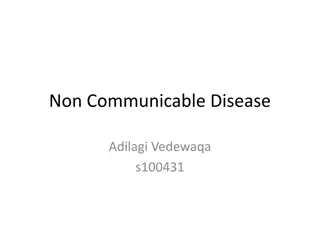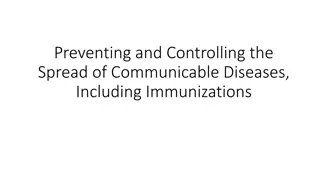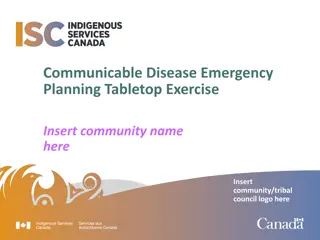Understanding Steatotic Liver Disease: Importance, Epidemiology, and Pathology
Steatotic liver disease, including metabolic dysfunction associated steatohepatitis (MASLD) and metabolic associated alcoholic liver disease (MALD), is a common cause of liver test abnormalities in the United States. Risk factors such as obesity and metabolic syndrome can lead to advanced fibrosis a
1 views • 44 slides
Innovations in Infectious Disease Control: Insights from Experts
Explore the latest advancements in infectious disease control through the lens of renowned epidemiologists and researchers. Delve into the impact of the COVID-19 pandemic, the historical prevalence of infectious diseases, and early infection prevention practices. Uncover the evolution of infectious
0 views • 22 slides
Understanding Non-Communicable Diseases and Prevention Strategies
Medical officer Dr. Richard Ayebare discusses non-communicable diseases (NCDs), highlighting their impact, common types in Uganda, cardiovascular risks, and modifiable vs. non-modifiable risk factors. Learn about the definition, worldwide picture, complications, and prevention methods of NCDs for a
0 views • 17 slides
Understanding the Natural History of Disease Development and Prevention
The natural history of disease development outlines the progression of a disease in an individual without intervention, from exposure to outcome. Learning objectives include defining prevention terms, understanding disease severity, prevention levels, and intervention measures. Studying disease prog
4 views • 16 slides
Best Neurosurgery Hospitals in India
Neuro diseases are very bad diseases. Many people are caught by Neuro diseases nowadays. It is related to brain diseases. Many people in India are caught by Neuro Diseases. It happens in Adults as well as children.\nA person of any age can be affected by this. Before this time very bad disease Named
1 views • 2 slides
At-Home HIV/STI Testing Pilot with Simple HealthKit
Communicable Disease Harm Reduction Section collaborated with Simple HealthKit to offer free HIV, syphilis, gonorrhea, chlamydia, and trichomoniasis testing to Wisconsin residents over 18 from August 25, 2023, to October 20, 2023. The aim was to make HIV and STI testing more accessible to those with
0 views • 23 slides
Understanding Non-Academic Requirements (NARs) for Clinical Placements at George Brown
Non-Academic Requirements (NARs) are essential documents needed for clinical placements at George Brown. These include Criminal Record Checks, communicable disease forms, immunizations, CPR certification, and more. NARs are crucial to safeguard students, staff, and patients, ensuring a safe learning
1 views • 19 slides
Principles of Epidemiology: Understanding Disease Occurrence and Surveillance
Epidemiology is the study of disease patterns, factors influencing disease occurrence, and the core functions of surveillance, field investigation, and analytic studies. It involves understanding disease characteristics, natural history, and evaluating the effectiveness of activities to mitigate dis
1 views • 25 slides
Understanding Epidemiology: Disease Distribution and Population Health
Epidemiology is the study of disease distribution in populations, analyzing patterns, determinants, and risk factors to understand and control various health conditions. It encompasses infectious diseases like cholera, nutritional disorders such as scurvy, cancers like childhood leukemia, and non-co
1 views • 16 slides
Heart Health Jeopardy - Test Your Knowledge on Heart Disease
Test your knowledge on heart disease with this Heart Health Jeopardy game. Learn about heart disease facts, statistics, risk factors, and common types of heart diseases. Understand the importance of recognizing heart attack symptoms and the significance of factors like high blood pressure, high chol
0 views • 58 slides
Insights into Tyzzer's Disease: An Overview of a Bacterial Infection in Laboratory Animals
Tyzzer's disease is an acute bacterial infection affecting rodents and rabbits, caused by Clostridium piliforme. Discovered in 1917 by Ernest Tyzzer, the disease is characterized by necrotic lesions in the caecal mucosa, liver, and heart. Initially known as Bacillus piliformis, it was later renamed
2 views • 21 slides
Importance of Screening and Separation in Marburg Virus Disease Control
Early identification and separation of suspected Marburg virus disease patients play a crucial role in preventing the spread of the disease within healthcare settings. Screening and setting up specific areas for identification and isolation are essential steps to protect healthcare workers, patients
1 views • 15 slides
Foot and Mouth Disease: Overview, Symptoms, and Sequelae
Foot and Mouth Disease, also known as Aphthous fever, is a highly contagious viral infection affecting cloven-hoofed animals. It is characterized by the formation of vesicles and erosions in the mouth, nose, teats, and feet. The disease can cause a fall in milk yield, high fever, loss of appetite, a
1 views • 8 slides
Continuous Learning Approach for Preventing Kidney Disease and Non-Communicable Diseases
Addressing the global health crisis of Non-Communicable Diseases (NCDs), particularly Kidney Disease, through comprehensive prevention strategies. Emphasizing the need for upstream primary prevention, utilizing surveillance systems, prediction analytics, and tailored messaging to drive awareness and
0 views • 13 slides
Understanding Disease Control and Prevention in Epidemiology
This article discusses disease control processes in epidemiology, including reducing disease incidence, duration, and transmission. It covers public policy interventions, elimination, eradication, and extinction of infectious agents. It also highlights preventable causes of disease and different lev
2 views • 10 slides
Integrated Disease Surveillance Programme (IDSP) Overview and Checklists
IDSP is a national health program launched in 2004 to monitor disease trends and respond to outbreaks. The program aims to strengthen disease surveillance systems and has specific checklists for service delivery and communicable diseases. The checklists include aspects like data utilization at distr
0 views • 9 slides
Enhancing Health Care Delivery through Ayushman Bharat Health and Wellness Centers
Ayushman Bharat Health and Wellness Centers aim to provide comprehensive primary health care services, including oral, mental, and geriatric care. These centers integrate service delivery to cover communicable and non-communicable diseases, focusing on preventive, curative, and rehabilitative care.
0 views • 39 slides
Understanding Communicable Diseases: A Global Perspective
Explore the dynamics of communicable diseases in the 6th edition of "Complimentary Teaching Materials - A Global Perspective" by Roger Webber. Learn about epidemic vs. endemic diseases, incubation periods, population dynamics, herd immunity, mathematical models for disease control, and various types
0 views • 13 slides
Global Health Challenges and Opportunities in the 21st Century
Unpacking the Sustainable Development Goals (SDGs), this content touches on important thresholds in global health, the impact of redefined priorities, the progress made since the MDGs, the rising burden of non-communicable diseases, lessons learned from the Ebola crisis, and challenges posed by urba
0 views • 14 slides
Machine Learning for Improved Risk Stratification in Health Care
Explore the use of machine learning for risk stratification of patients with non-communicable diseases in Estonia. This study showcases the application of big data and machine learning in healthcare, emphasizing the benefits of personalized care, proactive disease prevention, and efficient intervent
1 views • 77 slides
National Centre for Disease Control and Prevention (NCDC) in Saudi Arabia
The National Centre for Disease Control and Prevention (NCDC) in Saudi Arabia was established to address public health challenges through a multifactorial approach. By preventing and controlling communicable and non-communicable diseases, monitoring population health, and fostering public health sol
0 views • 8 slides
Guidelines for Summer Camps in Massachusetts during COVID-19
Massachusetts Department of Public Health outlines requirements for operating recreational camps during Phase II of COVID-19. Camps must self-assess, attest to meeting health & safety standards, and comply with specific safety standards for activities like swimming, sports, beaches, and playgrounds.
0 views • 15 slides
Screening for Peripheral Vascular Disease in Patients with Coronary Artery Disease
Patients with coronary artery disease should be screened for peripheral vascular disease as it is a frequent integrator of global cardiovascular risk. The association of atherosclerosis in various arterial diseases highlights the importance of identifying multisite artery disease. The prevalence and
0 views • 23 slides
Implementing Strategic Areas for Non-Communicable Disease Prevention
Implementation of national prevention and control programs for non-communicable diseases is crucial for sustainable healthcare systems. Collaborating with multidisciplinary groups and shifting advocacy paradigms towards human rights and social determinants of health are essential. A transformation i
1 views • 20 slides
Human Disease Symptom Network: Understanding Disease Relationships Through Symptoms and Genes
The Human Disease Symptom Network (HSDN) is constructed using a large-scale medical bibliographic records database to form a network of human diseases based on symptom similarities. By integrating disease-gene associations and protein-protein interaction data, correlations between symptom similarity
0 views • 37 slides
Understanding Bacterial Diseases of Fish: Columnaris Disease Overview
Columnaris disease, also known as Saddleback disease, is a common bacterial infection in fish that is often brought about by poor handling and high stress levels. This disease manifests as tail and fin rot, leading to rapid fish mortality. The causative organism, Cytophaga (formerly Flexibacter), is
0 views • 21 slides
Managing Communicable Disease Reporting in Childcare Facilities
Michigan law requires schools and childcare centers to report specific diseases promptly to the local health department. Reporting helps identify disease trends, outbreaks, and epidemics, enables preventative measures, aids in resource allocation, and supports disease surveillance efforts. Guideline
0 views • 18 slides
Disease Tabletop Exercise: Suspected Tuberculosis Response Plan
Local health jurisdictions in Montana are preparing for disease tabletop exercises focusing on activating emergency response plans for suspected tuberculosis cases. The exercise aims to engage public health partners, clarify response roles, and identify strengths and gaps in emergency preparedness p
0 views • 49 slides
Economic Development and Non-Communicable Diseases: Analyzing the Impact
This paper explores the economic dimensions of Non-Communicable Diseases (NCDs) such as alcohol, tobacco, junk food, and lack of exercise, which are largely preventable factors affecting economic development. Key concepts like unwholesome goods, demand and supply irrationality, and market power are
0 views • 22 slides
Decoding Genetics: Insights from Alzheimer's Disease Symposium to Type 2 Diabetes Study
Explore the latest findings from the Alzheimer's Disease Genetics Symposium 2019 on disease mechanisms, drug targets, and genetic pathways. Dive into the progress made by the Alzheimer's Disease Genetics Consortium over the past decade. Transition to a Genome-Wide Association Study uncovering suscep
0 views • 42 slides
Liver Disease Burden in Tower Hamlets
Dr. Somen Banerjee, Director of Public Health in London Borough Tower Hamlets, highlights the concerning liver disease mortality rates in the area, with high incidence of cirrhosis, cancer, and hepatitis B and C. The data reveals a significant burden of liver diseases such as Non-Alcoholic Fatty Liv
0 views • 18 slides
Understanding Inflammatory Bowel Disease: Crohn's Disease and Ulcerative Colitis
Inflammatory Bowel Disease (IBD) encompasses Crohn's disease (CD) and ulcerative colitis (UC), chronic conditions with immunologic basis. This article delves into the epidemiology, pathophysiology, and differences between CD and UC, highlighting clinical features, pathology, and complications like a
0 views • 42 slides
Managing Non-Communicable Diseases: Role of Health Care Providers
Non-communicable diseases (NCDs) like cardiovascular diseases, cancers, chronic respiratory diseases, and diabetes mellitus pose significant health challenges globally. This overview delves into the definition, epidemiology, and management strategies of NCDs, emphasizing the critical role of health
0 views • 18 slides
Understanding Non-Communicable Diseases and Global Action Plans
Non-communicable diseases (NCDs), such as cardiovascular diseases, cancers, chronic respiratory diseases, and diabetes, pose a major health threat globally, with 38 million deaths yearly. The Global Action Plan aims to reduce premature mortality from NCDs by 2025 through specific targets, including
0 views • 16 slides
Ultrastructural Alterations of Renal Tissue in a Male Patient with Fabry's Disease
Fabry's disease is a rare X-linked lipid storage disorder characterized by deficient lysosomal alpha-galactosidase A activity. This condition primarily affects males, leading to chronic kidney disease and progression to end-stage renal disease. Kidney involvement is a critical aspect, and high doses
0 views • 24 slides
Understanding and Preventing Communicable Diseases
Communicable diseases, also known as contagious or infectious diseases, are caused by germs such as viruses, bacteria, fungi, and parasites. These illnesses spread from person to person through various means like body fluids and can have different treatment approaches. It is essential to know how th
0 views • 34 slides
Understanding Bloodborne, Airborne, and Droplet Pathogens in Workplace Training
Explore the importance of annual training for employees in contact with blood or blood products, as mandated by OSHA. Learn about occupational exposure, exposure control plans, disease processes, and types of diseases caused by microorganisms. Gain insights into normal flora, infectious diseases, an
0 views • 76 slides
Community Emergency Planning Tabletop Exercise
This tabletop exercise focuses on preparing communities for communicable disease emergencies by understanding the nature of communicable diseases, emergencies, and tabletop exercises. Participants will discuss how communicable diseases spread, the characteristics of a communicable disease emergency,
0 views • 11 slides
Non-Academic Requirements (NARs) for Clinical Placements
Non-Academic Requirements (NARs) are essential documents mandated for clinical placements to ensure the safety of students, staff, and patients. These requirements include criminal record checks, communicable disease forms, tuberculosis testing, vaccinations, and other health and safety training. Co
0 views • 18 slides
China's Health Transitions: Diseases of Poverty and Affluence
China's health transitions encompass changes in medicine and population health, influenced by factors like demographic shifts, disease patterns, and societal determinants. Challenges with data accuracy and the country's 20th-century demographic evolution are highlighted, including issues related to
0 views • 15 slides








